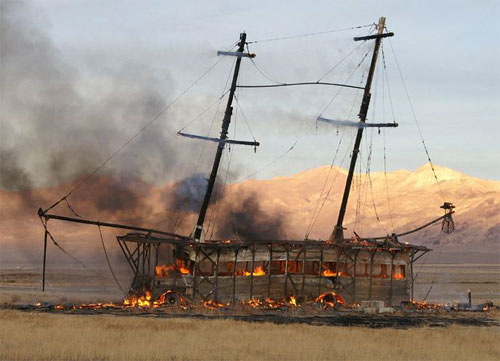Burners aren’t too worried about an appeal that’s been filed challenging federal permits that will allow more than 60,000 people to attend Burning Man this year, but some of them are more hopeful that a trial starting next week in Reno will finally get some justice in the 2006 arson attack that destroyed the iconic art car La Contessa.
Members of San Francisco’s colorful Extra Action Marching Band and other creators of La Contessa – an authentic-looking Spanish galleon built around a bus, which appeared to sail across the Black Rock Desert – have rented a house in Reno where they’re preparing for a trial set to begin on Monday.
As we reported in a Guardian cover story shortly after the incident, Nevada landowner Mike Stewart – who had a history of conflicts with Burning Man – torched and removed La Contessa, which was being stored with permission on a property that he purchased near Gerlach, Nev., without first trying to contact its owners. The massive vehicle was too large to legally drive on the highway and its builders say they would have relocated it if they were contacted, as state law requires before destroying abandoned vehicles.
This trial has been years in coming. Plaintiffs Simon Cheffins and Greg Jones – the main designers of La Contessa – originally filed a federal lawsuit under the Visual Artists Right Act, which makes it a crime to destroy sculptures or other works of art, but a judge ruled that La Contessa didn’t qualify because it was a vehicle and therefore “applied art.”
The case is now a simple “conversion claim” in state court, alleging Stewart acted in a malicious and negligent manner, but the trial is expected to last more than two weeks as a parade of Bay Area burners involved with the project paint a picture of the long and difficult process used to create the artwork and its iconic role in Burning Man history.
Meanwhile, the appeal of Burning Man’s permits was filed last week by Christopher Brooks, who uses the Black Rock Desert for wind sailing and alleges that Burning Man is impacting the playa’s surface by creating sand dunes. Black Rock City LLC, the SF-based company that stages Burning Man, denies the charge and says the detailed environmental assessment recently approved by the Bureau of Land Management (BLM) found no significant cumulative impacts created by the event.
“We’re not too concerned about it,” BRC spokesperson Megan Miller said of the appeal. “We work hard to minimize our impact on the desert.”
Regardless, the appeal won’t have an impact of this year’s event, which begins Aug. 26. The appeal will be heard by the Interior Board of Land Appeals, which is so backlogged that it still hasn’t heard BRC’s appeal of BLM’s decision to place Burning Man on probation for exceeding last year’s population cap of 50,000 on two days, which BRC filed late last year.
As Miller said, “We’re right on track for a great year.”
Guardian City Editor Steven T. Jones is the author of The Tribes of Burning Man: How an Experimental City in the Desert is Shaping the New American Counterculture, which includes the story of La Contessa’s life and death.

